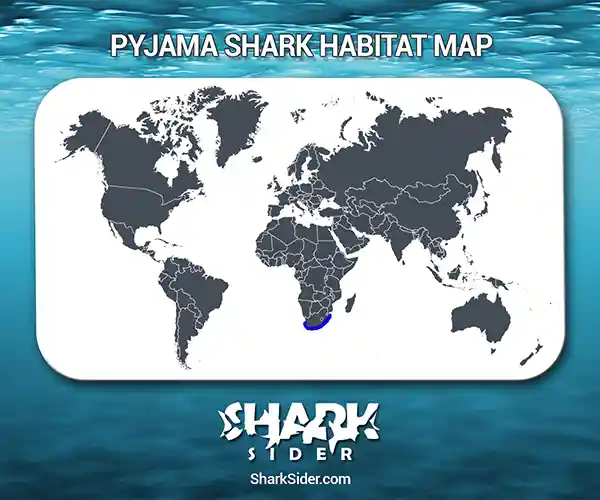The pyjama shark is a species of catshark living off the coast of South Africa. Also known as the striped catshark, it is easily recognizable due to the dark stripes running down its body.
Pyjama Shark Scientific Classification |
|
| Kingdom | Animalia |
| Phylum | Chordata |
| Class | Chondrichthyes |
| Order | Carcharhiniformes |
| Family | Scyliorhinidae |
| Genus | Poroderma |
| Scientific Name | P. africanum |
Description
These sharks are generally 3.6 ft long and weigh about 17 lbs. Its head and snout are short and flat, and each nostril has a skin flap covering it. These flaps have a three-shaped lobe with the central part having a barbel emerging. The eyes are oval-shaped on top of the shark’s head and have protective third eyelids. Their mouths form a broad arch with short furrows on both jaws. Inside the shark’s mouth are 18–25 teeth rows in the upper jaw and 14–24 tooth rows in the lower one.
There are several fins all over their compressed body. These include two dorsal fins lower down the back of the shark, with the first being larger than the second, two large and broad pectoral fins, pelvic fins whose inner margins form an “apron” that covers its genitalia, and a short and broad caudal fin.
Pyjama sharks have a very distinct coloration, with 5-7 dark parallel stripes running horizontally down a brownish or greyish background. The underside is lighter, with spots present in certain specimens.
Where do they live
Map Of The Pyjama Shark’s Habitat

It lives off the coast of South Africa, ranging from Table Bay off Cape Town to the north of East London, with sightings in the Western Cape, KwaZulu-Natal, and Saldanha Bay.
They swim in shallow, intertidal waters at a maximum depth of 16 ft around rocky reefs and kelp beds.
Behavior
Hunting
Pyjama sharks feed on various creatures, including bivalves, bony fishes like anchovies, gurnards, and hakes, cephalopods, crustaceans, hagfishes, polychaete worms, and smaller sharks and rays and their egg cases.
The preferred prey of a pyjama shark will change depending on its location. For instance, the Cape rock lobster is the most consumed species of prey in False Bay.
They twist and tear the tentacles of cephalopods to incapacitate them before consuming them. While they usually only hunt at night, they change this pattern during the breeding period of the chokka squid. They will hide among the egg masses, and the shark will attack when the squids descend to lay more eggs.
Social
During summer, this shark will form groups.
Reproductive
They are oviparous and reproduce throughout the year. Each egg is contained inside a dark brown, tough, rectangular capsule that is 3.7 inches long and 1.8 inches across. It has tendrils to tether themselves to algae stipes or gorgonians. When hatching, the newborn shark measures 5.5–5.9 inches long.
Sexual maturity is observed in males when they are 31–32 inches long and in females when they are 31–33 inches long.
Interactions with humans
While this shark is harmless to humans, they are challenging to approach underwater. However, they are a common sight in public aquariums.
Commercial fisheries and recreational anglers often capture them by accident. They then kill the captured sharks as they eat bait for other fish and sharks. Its population remains steady, so the IUCN classifies the pyjama shark as “Least Concern” or “LC”.
